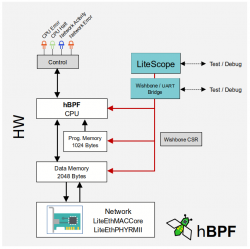Friday, September 10, 2021
Today’s BLOG entry is about a simple hack that can make your life easier when working with serial USB devices under Linux (Ubuntu/Debian). Every time a device is attached, an automatically generated device name is assigned to it by the OS (e.g. /dev/ttyUSB1). When you work a lot with embedded devices, using their serial USB devices for developing and testing, it could be a real pain to always change their names in a terminal program or some config files. Especially when using multiple devices concurrent, connecting and disconnecting them in different order, creates a device name lottery and very quickly you no longer know which device is connected to which device name.
[Read more…]
 hBPF + LiteETH for real network packet processing
hBPF + LiteETH for real network packet processing
This project shows how to process real network packets with hBPF. It uses a Digilent Arty-S7 with a MultiNet expansion board.
The Arty-S7 does not have Ethernet out of the box. Therefore Ethernet for the Arty-S7 was provided using MultiNet.
The project instantiates a hBPF CPU and connects it to a LiteEth low level LiteEthMACCore to receive network packets. Some CPU status signals are connected to LED’s. A serial Wishbone Bridge and LiteScope Debugger are used for debugging.
[Read more…]
 Introducing hBPF - an eBPF implementation for FPGAs.
Introducing hBPF - an eBPF implementation for FPGAs.
This project was started beginning of 2021 as an experiment of how fast and how far you can get, with using alternate hardware description languages (compared to the classic ‘V’ languages VHDL and Verilog), most of the time open-source tools (compared to expensive, commercial toolchains) and cheap development boards (e.g Arty-S7).
It implements an eBPF CPU using LiteX/Migen, a Python3 based SoC builder and Hardware Definition language (HDL).
[Read more…]

